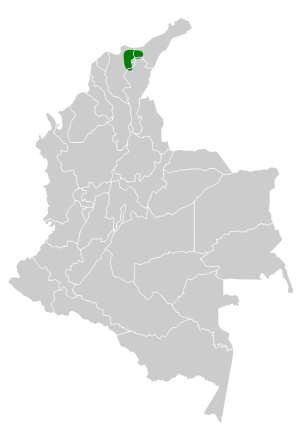Santa Marta tapaculo facts for kids
Quick facts for kids Santa Marta tapaculo |
|
|---|---|
| Conservation status | |
| Scientific classification | |
| Genus: |
Scytalopus
|
| Species: |
sanctaemartae
|
 |
|
The Santa Marta tapaculo (Scytalopus sanctaemartae) is a small bird that belongs to the family Rhinocryptidae. This special bird lives only in one place: the Sierra Nevada de Santa Marta mountains in Colombia. This means it is an endemic species.
Contents
What is a Santa Marta Tapaculo?
The Santa Marta tapaculo is a unique bird found only in a specific part of Colombia. It was once thought to be a type of rufous-vented tapaculo. However, scientists realized it was a completely different species. They made this discovery mainly by listening to its unique songs and calls.
How to Spot a Santa Marta Tapaculo
This bird is about 11 cm (4.3 in) long, which is roughly the size of a small sparrow.
- Males: They have a medium gray head and back. Their throat and chest are a lighter gray. Look closely, and you might see a small white patch on the top of their head! Their lower back is a brownish-orange color with black stripes. The sides of their body are rusty with black stripes too.
- Females: Their upper body has a brownish tint and they are lighter in color underneath compared to the males. The white patch on their head is either very small or not there at all.
- Young Birds: Baby tapaculos have many strong stripes and scale-like patterns on their feathers.
Where Does This Bird Live?
The Santa Marta tapaculo lives only in the isolated Sierra Nevada de Santa Marta mountain range in northeastern Colombia. These mountains are very special because they are surrounded by lower lands, making them like an island in the sky for many unique animals and plants.
This tapaculo prefers to live in dense, humid montane forests. These are forests found on mountainsides where it's often wet and misty. You can find them at elevations between 900 and 1,700 m (3,000 and 5,600 ft) above sea level.
Behavior and Life Cycle
Like most tapaculos, the Santa Marta tapaculo spends most of its time on the ground. It likes to hide in the thick bushes and plants.
What Does It Eat?
Scientists don't know much about what the Santa Marta tapaculo eats or how it finds its food. More research is needed to understand its diet.
Reproduction
There isn't much information about how these birds raise their young. We only know that a young tapaculo was found in July, which gives us a small clue about when they might be breeding.
Sounds and Calls
The Santa Marta tapaculo is known for its distinct sounds.
- Song: It sings a fast, trilling song that can last up to 15 seconds! You can listen to an example here: [1].
- Call: Its call is a sharp, squeaky sound that it repeats. You can hear an example here: [2].
Conservation Status
The IUCN (International Union for Conservation of Nature) has listed the Santa Marta tapaculo as "Near Threatened." This means that while it's not in immediate danger, its population could become threatened in the future.
Even though it lives in a small area and we don't know the exact number of these birds, scientists believe there are enough of them for now. However, protecting their mountain home is very important to keep them safe.
See also
 In Spanish: Churrín de Santa Marta para niños
In Spanish: Churrín de Santa Marta para niños


